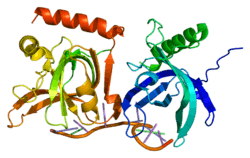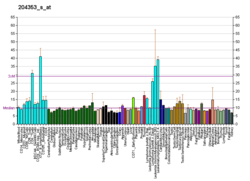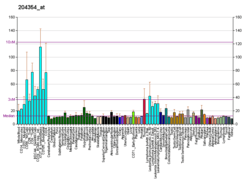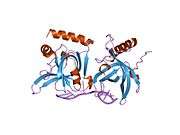POT1
Protection of telomeres protein 1 is a protein that in humans is encoded by the POT1 gene.[5][6][7]
Function
This gene is a member of the telombin family and encodes a nuclear protein involved in telomere maintenance. Specifically, this protein functions as a member of a multi-protein complex known as shelterin, that binds to the TTAGGG repeats of telomeres, regulating telomere length and protecting chromosome ends from illegitimate recombination, catastrophic chromosome instability, and abnormal chromosome segregation. Alternatively spliced transcript variants have been described.[7]
The absence of POT1 in mouse embryonic fibroblasts and chicken cells leads to a detrimental DNA damage response on telomeres resulting in telomere dysfunction-induced foci (TIFs). POT1 is required for telomere protection because it allows for telomere inhibition of DNA damage response factors. The protein also serves a role in the regulation of telomerase activity on telomeres. In vitro experiments utilizing human POT1 have shown that reduction in POT1 levels result in the elongation of telomeres.[8]
Interactions
POT1 has been shown to interact with ACD[9][10][11] and TINF2.[10][11][12]
Pathology
- Increased transcriptional expression of this gene is associated with stomach carcinogenesis and its progression.
- Mutations in this gene have also been associated to the acquisition of the malignant features of chronic lymphocytic leukemia.[13]
- POT1 loss-of-function variants predispose to familial melanoma[14] and glioma.[15]
References
- 1 2 3 GRCh38: Ensembl release 89: ENSG00000128513 - Ensembl, May 2017
- 1 2 3 GRCm38: Ensembl release 89: ENSMUSG00000029676 - Ensembl, May 2017
- ↑ "Human PubMed Reference:".
- ↑ "Mouse PubMed Reference:".
- ↑ Baumann P, Cech TR (May 2001). "Pot1, the putative telomere end-binding protein in fission yeast and humans". Science. 292 (5519): 1171–5. doi:10.1126/science.1060036. PMID 11349150.
- ↑ Baumann P, Podell E, Cech TR (November 2002). "Human Pot1 (protection of telomeres) protein: cytolocalization, gene structure, and alternative splicing". Molecular and Cellular Biology. 22 (22): 8079–87. doi:10.1128/MCB.22.22.8079-8087.2002. PMC 134737. PMID 12391173.
- 1 2 "Entrez Gene: POT1 POT1 protection of telomeres 1 homolog (S. pombe)".
- ↑ Bauman P, Carolyn P (2010). "Pot1 and telomere maintenance". FEBS Letters. 584 (17): 3779-3784. doi:10.1016/j.febslet.2010.05.024. PMC 2942089.
- ↑ Rual JF, Venkatesan K, Hao T, Hirozane-Kishikawa T, Dricot A, Li N, et al. (October 2005). "Towards a proteome-scale map of the human protein-protein interaction network". Nature. 437 (7062): 1173–8. doi:10.1038/nature04209. PMID 16189514.
- 1 2 Ye JZ, Hockemeyer D, Krutchinsky AN, Loayza D, Hooper SM, Chait BT, de Lange T (July 2004). "POT1-interacting protein PIP1: a telomere length regulator that recruits POT1 to the TIN2/TRF1 complex". Genes & Development. 18 (14): 1649–54. doi:10.1101/gad.1215404. PMC 478187. PMID 15231715.
- 1 2 Liu D, Safari A, O'Connor MS, Chan DW, Laegeler A, Qin J, Songyang Z (July 2004). "PTOP interacts with POT1 and regulates its localization to telomeres". Nature Cell Biology. 6 (7): 673–80. doi:10.1038/ncb1142. PMID 15181449.
- ↑ Loayza D, De Lange T (June 2003). "POT1 as a terminal transducer of TRF1 telomere length control". Nature. 423 (6943): 1013–8. doi:10.1038/nature01688. PMID 12768206.
- ↑ Ramsay AJ, Quesada V, Foronda M, Conde L, Martínez-Trillos A, Villamor N, et al. (May 2013). "POT1 mutations cause telomere dysfunction in chronic lymphocytic leukemia". Nature Genetics. 45 (5): 526–30. doi:10.1038/ng.2584. PMID 23502782.
- ↑ Robles-Espinoza CD, Harland M, Ramsay AJ, Aoude LG, Quesada V, Ding Z, et al. (May 2014). "POT1 loss-of-function variants predispose to familial melanoma". Nature Genetics. 46 (5): 478–481. doi:10.1038/ng.2947. PMC 4266105. PMID 24686849.
- ↑ Bainbridge MN, Armstrong GN, Gramatges MM, Bertuch AA, Jhangiani SN, Doddapaneni H, et al. (January 2015). "Germline mutations in shelterin complex genes are associated with familial glioma". Journal of the National Cancer Institute. 107 (1): 384. doi:10.1093/jnci/dju384. PMC 4296199. PMID 25482530.
Further reading
- de Lange T (September 2005). "Shelterin: the protein complex that shapes and safeguards human telomeres". Genes & Development. 19 (18): 2100–10. doi:10.1101/gad.1346005. PMID 16166375.
- Bonaldo MF, Lennon G, Soares MB (September 1996). "Normalization and subtraction: two approaches to facilitate gene discovery". Genome Research. 6 (9): 791–806. doi:10.1101/gr.6.9.791. PMID 8889548.
- Loayza D, De Lange T (June 2003). "POT1 as a terminal transducer of TRF1 telomere length control". Nature. 423 (6943): 1013–8. doi:10.1038/nature01688. PMID 12768206.
- Colgin LM, Baran K, Baumann P, Cech TR, Reddel RR (May 2003). "Human POT1 facilitates telomere elongation by telomerase". Current Biology. 13 (11): 942–6. doi:10.1016/S0960-9822(03)00339-7. PMID 12781132.
- Loayza D, Parsons H, Donigian J, Hoke K, de Lange T (March 2004). "DNA binding features of human POT1: a nonamer 5'-TAGGGTTAG-3' minimal binding site, sequence specificity, and internal binding to multimeric sites". The Journal of Biological Chemistry. 279 (13): 13241–8. doi:10.1074/jbc.M312309200. PMID 14715659.
- Kondo T, Oue N, Yoshida K, Mitani Y, Naka K, Nakayama H, Yasui W (January 2004). "Expression of POT1 is associated with tumor stage and telomere length in gastric carcinoma". Cancer Research. 64 (2): 523–9. doi:10.1158/0008-5472.CAN-03-1196. PMID 14744765.
- Armbruster BN, Linardic CM, Veldman T, Bansal NP, Downie DL, Counter CM (April 2004). "Rescue of an hTERT mutant defective in telomere elongation by fusion with hPot1". Molecular and Cellular Biology. 24 (8): 3552–61. doi:10.1128/MCB.24.8.3552-3561.2004. PMC 381596. PMID 15060173.
- Liu D, Safari A, O'Connor MS, Chan DW, Laegeler A, Qin J, Songyang Z (July 2004). "PTOP interacts with POT1 and regulates its localization to telomeres". Nature Cell Biology. 6 (7): 673–80. doi:10.1038/ncb1142. PMID 15181449.
- Ye JZ, Hockemeyer D, Krutchinsky AN, Loayza D, Hooper SM, Chait BT, de Lange T (July 2004). "POT1-interacting protein PIP1: a telomere length regulator that recruits POT1 to the TIN2/TRF1 complex". Genes & Development. 18 (14): 1649–54. doi:10.1101/gad.1215404. PMC 478187. PMID 15231715.
- Lei M, Podell ER, Cech TR (December 2004). "Structure of human POT1 bound to telomeric single-stranded DNA provides a model for chromosome end-protection". Nature Structural & Molecular Biology. 11 (12): 1223–9. doi:10.1038/nsmb867. PMID 15558049.
- Veldman T, Etheridge KT, Counter CM (December 2004). "Loss of hPot1 function leads to telomere instability and a cut-like phenotype". Current Biology. 14 (24): 2264–70. doi:10.1016/j.cub.2004.12.031. PMID 15620654.
- Kelleher C, Kurth I, Lingner J (January 2005). "Human protection of telomeres 1 (POT1) is a negative regulator of telomerase activity in vitro". Molecular and Cellular Biology. 25 (2): 808–18. doi:10.1128/MCB.25.2.808-818.2005. PMC 543404. PMID 15632080.
- Yang Q, Zheng YL, Harris CC (February 2005). "POT1 and TRF2 cooperate to maintain telomeric integrity". Molecular and Cellular Biology. 25 (3): 1070–80. doi:10.1128/MCB.25.3.1070-1080.2005. PMC 544002. PMID 15657433.
- Lei M, Zaug AJ, Podell ER, Cech TR (May 2005). "Switching human telomerase on and off with hPOT1 protein in vitro". The Journal of Biological Chemistry. 280 (21): 20449–56. doi:10.1074/jbc.M502212200. PMID 15792951.







